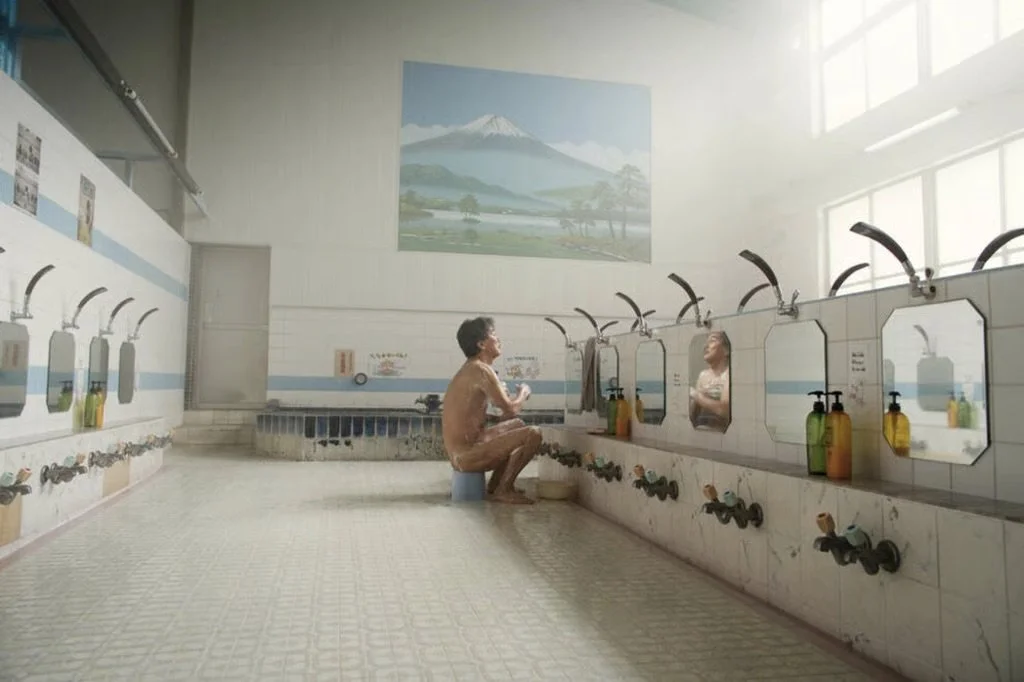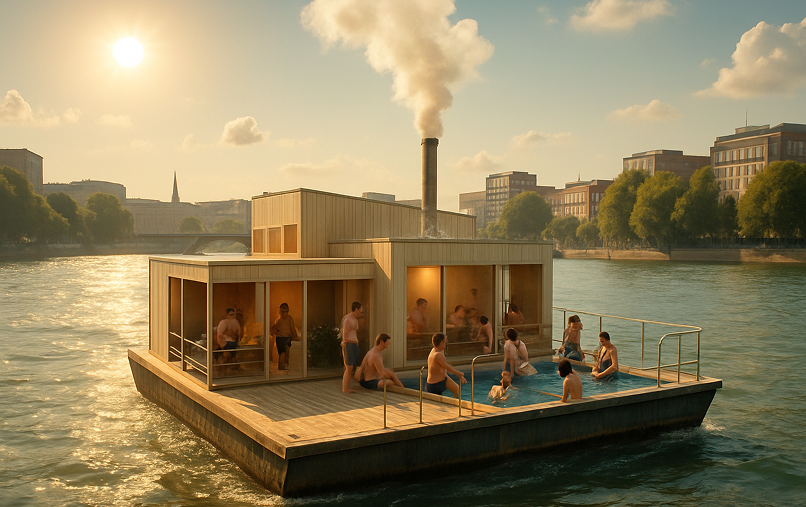ISSUE 08: SQUEAKY CLEAN
→ Romans and Ottomans made bathhouses the centre of civic life
→ Communal bathing declined in the West with private plumbing
→ Could bathhouses make a comeback as social and wellness hubs for overheated, dense cities?
Cities are running hot, both literally and metaphorically. Rising urban temperatures, overstretched infrastructure, and a growing desire for restorative rituals are reshaping how we think about shared public spaces. So what can we do about it? Well, one idea that feels strangely futuristic: the ancient bathhouse.
Across cultures, bathhouses have been sites of cleansing, connection, and cultural life for millennia. Today, as the wellness economy grows, they may be poised for a revival. Bathhouses not just as boutique spa experiences for the few, but as they were originally envisioned: as civic infrastructure for the many.
A
What Was
In ancient Rome, the bathhouse wasn’t just a place to wash — it was a hub of community, politics, and leisure. A spot where the populace could gather to gossip and discuss. These bathing spots ranged in style from the grandiose to the more subdued, but in general, tended to be rather large, state-built spaces for hundreds to use.
For example, the Baths of Caracalla (completed in 216 CE) sprawled across 25 hectares, accommodating up to 1,600 bathers at once. They were built across the Roman empire, often utilizing natural thermal waters to keep the pools nice and warm. From the UK to Algeria, there were similar complexes that embodied collective Roman ideals of civic life.
The Roman Baths that gave the city it’s name: Bath, UK
The Romans weren’t the first to offer public bathing infrastructure. Egyptians, Greeks, and ancient civilizations in the Indus Valley all had versions of public baths for their citizens to use.
The Ottomans carried on the tradition with hammams (also referred to as the Turkish Bath), where patrons could go for ritual purification and everyday socializing. Hammams were more than architectural marvels of domes and intricate mosaics, they served as democratic spaces where all social classes from merchants, artisans, to nobles could gather to share conversations.
Sultan Amir Ahmad Bathhouse in Kashan, Iran. (Image source)
The public baths declined in popularity as modernization saw more houses outfitted with bathrooms. By the mid-20th century, communal bathhouses largely disappeared — except in places like Japan (where the onsen and sentō are still popular), Finland (saunas), and Turkey (hammams), where traditions continue to endure.
B
What Is
As mentioned, communal bathing hasn’t disappeared; it has just transformed and rebranded around the world.
In Japan the sentō and onsen remain cultural staples, offering affordable access to hot water, mineral springs, and ritualized relaxation. The sentō is a traditional and more utilitarian communal bathhouse that can be found in urban settings. On the other hand, the onsen is heated by natural hot springs and is often located in more natural, spa-like settings.
Meanwhile, in Nordic countries sauna culture is so embedded that some workplaces include saunas as standard employee benefits. Helsinki even built the Löyly Sauna (2016), a wonderfully modern public waterfront sauna.
One of the most famous examples of European bathhouses is Budapest’s Szechenyi baths and pools. Set in a grandiose building, it features multiple pools at various temperatures along with spa-like treatments.
Szechenyi Baths in Budapest. (Image source)
Around the world, we’re also seeing the emergence of boutique bathhouses, often marketed as wellness escapes and spas. Take for example AIRE Ancient Baths which recreates Roman-style pools in renovated buildings cities around the world.
Other noteworthy examples of public baths include Iceland’s famous Blue Lagoon and Sky Lagoon which integrates geothermal pools with architecture that blends into the coastal cliffs.
Of course one of the big questions is what differentiates a public bath from a modern pool, especially as many of the examples shared above fall more into the pool category than the traditional public bath. Well, the way I see it, a public bath focuses on offering a communal space focused on hygiene and relaxation, while a pool offers a shared space primarily used for aquatic recreation (swimming). Pools tend to be maintained with more chemicals than baths which may be warmer and feature more natural waters better suited for therapeutic use.
C
What Next
So, what’s next for bathhouses? Quite a lot, actually. Around the world, we’re already seeing hints that communal bathing could shift from a niche wellness trend to a more mainstream urban fixture.
Take the problem of urban overheating. Cities are working to design “cool refuges” where people can escape extreme heat. Maybe some day future bathhouses could double as climate relief centers.
Community saunas as social spaces (Image source)
At the same time, let’s not forget that the wellness economy is booming. As outlined earlier, boutique bathhouses in New York, London, and Berlin are packaging ancient rituals into sleek, modern spa-like experiences. What was once seen as outdated infrastructure is slowly being rebranded as a luxury therapeutic experience.
Then there’s the question of resources. A shared model, where one beautifully designed bathhouse serves a neighbourhood, could become a logical response to future water and energy constraints. Whether people buy into it or not depends on a myriad of factors.
And perhaps most surprisingly, the loneliness epidemic might be the strongest pull of all. Beyond their health benefits, bathhouses have always served as a type of social commons. Steam-filled rooms and warm pools acting as neutral meeting grounds where different generations, cultures, and backgrounds can come together. In some parts of the world, saunas and communal bathing can even be recommended by health practitioners as remedies against social isolation and to support the management of chronic pain.
D
What If
Climate Commons
Imagine public bathhouses designed as a type of future “climate relief centers,” offering cool pools in the summer and warm steam rooms in the winter. Outfitted with shaded courtyards perfect for those climate change-induced heatwaves.
Pop-Up Bath Pods
Portable micro-bathhouses that could be deployed at festivals, refugee camps, disaster zones, plazas, and parks — like food trucks but for wellness. They could be powered by solar, reclaimed rainwater, and/or bio-heating.
Yes, this is an AI-generated image with sub-par text details.
Digital Hammams
Hybrid spaces where VR/AR overlays mix with the sensory experience of steam and water. Perhaps it’s a type of hammam where the tiles come alive with shifting constellations or guided meditations.
But maybe without the headsets, just animated walls?
Subscription Bathhouses
Instead of a gym, your membership gives you access to a network of urban bathhouses. Think co-working, but for sweating, soaking, and socializing.
Floating Bath Barge
On overheated summer days, a modular bathhouse floats into the city via river or harbour. Residents hop aboard to soak, sweat, and cool down.
Spa Village
Like a sort of wellness resort meets theme park. A large facility that has different zones that are themed for different styles of wellness treatments. Japanese corner features onsens, the Nordic corner has saunas and cold plunges, while the Turkish corner features aromatic hammams, and the Balinese area has lush pools.
E
So What
Positives
Energy Efficiency
Shared infrastructure conserves energy and water, especially if heated through geothermal, solar, or other environmentally friendly process.
Inclusivity
Bringing back the public bath as public infrastructure creates accessible, inclusive wellness spaces for all.
Social Life
These types of spaces help build civic life and combat loneliness by offering a place to socialize.
Negatives
Health Risks
There could be important health risks to public bathing without proper maintenance.
Low Adoption / Culture Shock
There could certainly be cultural pushback in societies with strong privacy norms.
Other Considerations
Resilience Infrastructure
Could governments fund bathhouses as resilience infrastructure, like swimming pools, cooling centers, or public libraries? Why couldn’t therapeutic pools be offered as a public amenity?
Bathhouses remind us that hygiene, mental and physical health, and community are interlinked. The question today isn’t whether bathhouses will return — they already are. The real question is: will they return as luxury spas for the few, or civic infrastructures for the many?












